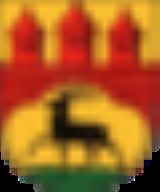
Stolberg-Stolberg
Encyclopedia
_22.jpg)
County
A county is a jurisdiction of local government in certain modern nations. Historically in mainland Europe, the original French term, comté, and its equivalents in other languages denoted a jurisdiction under the sovereignty of a count A county is a jurisdiction of local government in certain...
of the Holy Roman Empire
Holy Roman Empire
The Holy Roman Empire was a realm that existed from 962 to 1806 in Central Europe.It was ruled by the Holy Roman Emperor. Its character changed during the Middle Ages and the Early Modern period, when the power of the emperor gradually weakened in favour of the princes...
located in the southern Harz
Harz
The Harz is the highest mountain range in northern Germany and its rugged terrain extends across parts of Lower Saxony, Saxony-Anhalt and Thuringia. The name Harz derives from the Middle High German word Hardt or Hart , latinized as Hercynia. The legendary Brocken is the highest summit in the Harz...
region. Its capital was the town of Stolberg, now in Saxony-Anhalt
Saxony-Anhalt
Saxony-Anhalt is a landlocked state of Germany. Its capital is Magdeburg and it is surrounded by the German states of Lower Saxony, Brandenburg, Saxony, and Thuringia.Saxony-Anhalt covers an area of...
, Germany
Germany
Germany , officially the Federal Republic of Germany , is a federal parliamentary republic in Europe. The country consists of 16 states while the capital and largest city is Berlin. Germany covers an area of 357,021 km2 and has a largely temperate seasonal climate...
.
In 1429 the County of Wernigerode
County of Wernigerode
The County of Wernigerode was a county of the Holy Roman Empire, located in the Harzgau region of the former Duchy of Saxony, at the northern foot of the Harz mountain range...
passed to the Counts of Stolberg, who ruled Wernigerode through a personal union
Personal union
A personal union is the combination by which two or more different states have the same monarch while their boundaries, their laws and their interests remain distinct. It should not be confused with a federation which is internationally considered a single state...
. In 1548 the line was split between a Harz line (Stolberg-Stolberg) and a Rhenish line which had possessions in Rochefort
Rochefort, Belgium
Rochefort is a Walloon municipality located in the Belgian province of Namur close to the Ardennes. On January 1, 2006 Rochefort had a total population of 12,038. The total area is 165.27 km² which gives a population density of 73 inhabitants per km²...
(Stolberg-Rochefort) and Königstein im Taunus
Königstein im Taunus
Königstein im Taunus is a climatic spa and lies on the thickly wooded slopes of the Taunus in Hesse, Germany. Owing to its advantageous location for both scenery and transport on the edge of the Frankfurt Rhine Main Region, Königstein is a favourite residential town...
(Stolberg-Königstein).
With the death of Count Wolf Georg zu Stolberg in 1631, Stolberg-Stolberg was inherited by members of the Rhenish line. On 31 May 1645 Stolberg-Stolberg was divided between a senior Stolberg-Wernigerode
Stolberg-Wernigerode
The Principality of Stolberg-Wernigerode was a county of the Holy Roman Empire located in the Harz region around Wernigerode, now part of Saxony-Anhalt, Germany.-History:...
line and a junior Stolberg-Stolberg line. In 1706, Stolberg-Stolberg divided again, with Stolberg-Rossla
Stolberg-Rossla
The County of Stolberg-Rossla was a county of the Holy Roman Empire. Its capital was Roßla, now in Saxony-Anhalt, Germany.Stolberg-Rossla emerged as a partition of Stolberg-Stolberg in 1706. It was forced to recognize the suzerainty of the Electorate of Saxony in 1738. Stolberg-Rossla was...
being created.
Stolberg-Stolberg was forced to recognize the suzerainty of the Electorate of Saxony
Electorate of Saxony
The Electorate of Saxony , sometimes referred to as Upper Saxony, was a State of the Holy Roman Empire. It was established when Emperor Charles IV raised the Ascanian duchy of Saxe-Wittenberg to the status of an Electorate by the Golden Bull of 1356...
in 1738. It was awarded to the Kingdom of Prussia
Kingdom of Prussia
The Kingdom of Prussia was a German kingdom from 1701 to 1918. Until the defeat of Germany in World War I, it comprised almost two-thirds of the area of the German Empire...
in the 1815 Congress of Vienna
Congress of Vienna
The Congress of Vienna was a conference of ambassadors of European states chaired by Klemens Wenzel von Metternich, and held in Vienna from September, 1814 to June, 1815. The objective of the Congress was to settle the many issues arising from the French Revolutionary Wars, the Napoleonic Wars,...
.
The children of Fürsten and Erbprinzen zu Stolberg-Wernigerode bore the title Prince[ss] (Prinz[essin]) zu Stolberg-Wernigerode and were styled Serene Highness
Serene Highness
His/Her Serene Highness is a style used today by the reigning families of Liechtenstein and Monaco. It also preceded the princely titles of members of some German ruling and mediatised dynasties as well as some non-ruling but princely German noble families until 1918...
. Other members of this line bore the title Count[ess] (Graf/Gräfin) zu Stolberg-Wernigerode, with the style Illustrious Highness
Illustrious Highness
His/Her Illustrious Highness is the English-language form for a style used by various members of the European aristocracy....
.

